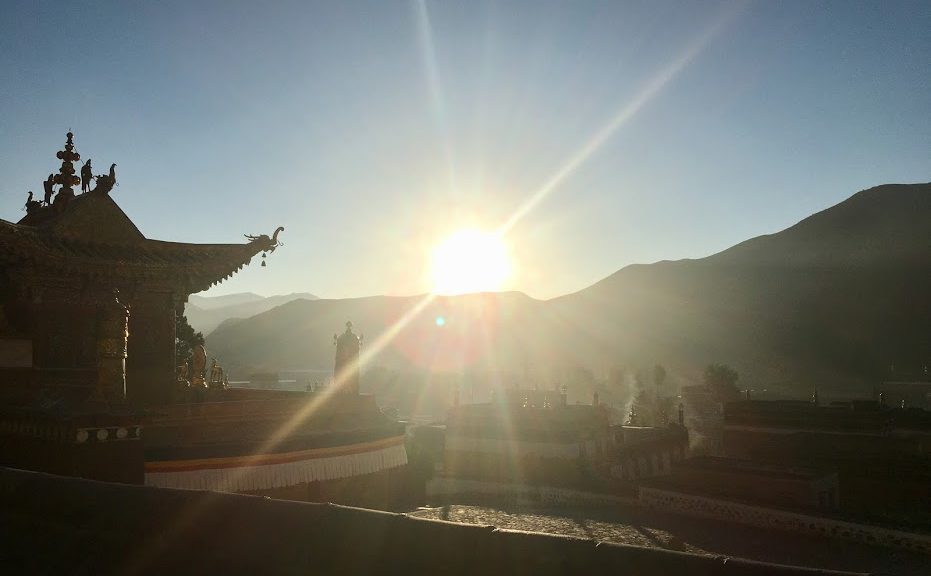
The Silk Road Excursion (Part 2): In the Mountains of Xia’he
Welcome back to the Silk Road, everyone! In my last blog about our amazing excursion, I described our adventures in the ancient capital city of Xi’an, where I had a personal encounter with the Terracotta Warriors and some mouth-watering yummy crispy meat buns. Now, let’s dive back in with the second destination of our trip: Xia’he, a Tibetan monastery town tucked away in a mountain valley at the edge of the Tibetan plateau. If I had to choose a favorite out of all of the places we went to, I would choose Xia’he, and I’m about to tell you why.
But First, Some Lanzhou Beef Noodles
So, our second overnight train ride was a little rough. We got on the train to Lanzhou around 11pm after spending our second day in Xi’an, exhausted from our day activities. Actually, we had to tip-toe onto our train since most people on the train were sound asleep. We all were spread out amongst three different train carts instead of being in one cart. Granted, this train ride had only been about 9 hours and was during the late night hours (a.k.a. prime recharge-your-battery hours), but it was harder to sleep soundly since most of us were surrounded by strangers. Nevertheless, most of us managed to tuck ourselves away into bed and get some rest.
We arrived in Lanzhou the following morning around 8am and were met by our next local tour guide, Peter. Peter was a very kind and soft-spoken man. He was very knowledgeable about both Lanzhou and Xia’he, and he taught us many things about Tibetan culture as well as Buddhism. I fondly remember Peter running off of our bus multiple times to buy us all packs of water, and I remember him joking around with us students throughout the time we spent with him as our tour guide. Many of us consider him to be one of our favorite tour guides on the trip because of his calm demeanor and easy-going attitude.
Lanzhou was, for centuries, a major stop on the Silk Road because it was essentially a crossroads in the route: the southwest had Xia’he and the northwest had the desert landscapes of Dunhuang and Jiayuguan. The fact that Lanzhou literally had the Yellow River flowing through it made it a perfect rest stop for weary travelers. We didn’t stay in Lanzhou for long, however: we only briefly stopped in town for breakfast. On the menu was Lanzhou’s famous hand-pulled beef noodles. The broth was rich and the noodles were delectably chewy, and we were able to customize what we wanted to put into our soup, like a choice of various slices of meats and veggies. Noodles for breakfast gave all of us some much needed fuel after that rough overnight train ride.
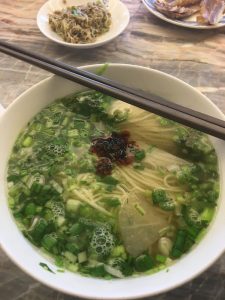
Once we finished our breakfast, we hopped onto our bus for the 4 hour ride up into the mountains to get to Xia’he. I don’t remember much of that 4 hour bus ride since I slept most of the time (I personally had not gotten much rest on that overnight train). But when I did wake up, I was met by bewildering and majestic sights: mountains and valleys covered by various greenery and kissed by beautiful blue skies that were dotted by fluffy white clouds. It was like the weather was welcoming us as we drew closer to our destination.

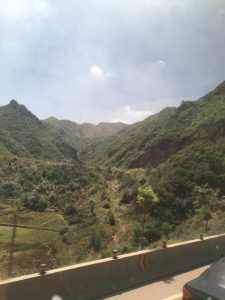
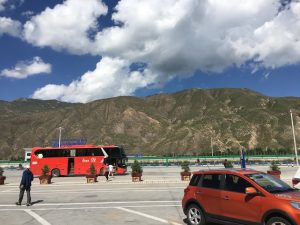
Welcome to Xia’he
Finally, after 4 hours, we arrived in Xia’he. The city, in comparison, was much cooler than Xi’an because of its elevated location in the mountains. I believe Peter said that the city was perched at around 8,000 feet above sea level.
I’ll repeat that.
8,000 feet above sea level.
The air wasn’t noticeably thinner unless you were exercising (later on, we would hike even higher up into the mountains to get to the sky burial site, and all of us definitely noticed the missing oxygen in the air). But we were warned to not strain ourselves while in Xia’he as a precaution against altitude sickness.
Xi’an was consistently in the high 80s and even 90s, but Xia’he’s temperature hung out around the low 70s. Most of us were thriving in long pants and jackets and sweaters. The air was noticeably more cleaner, more fresher, and somehow, more crisper. Well, it was when we got away from the area around our hotel since Xia’he’s streets were underneath construction during our visit. The people also preferred to speak Tibetan than Mandarin (remember, Xia’he is on the edge of the Tibetan plateau), and it was one of the first times where those of us who spoke some Mandarin ran into situations where they could not directly communicate with the locals. Luckily for us, most people were able to understand and speak some Mandarin, and hand gestures and smiles are part of the universal language.
To welcome us to their hotel, the hotel owners draped a long white silk scarf, called a “khata,” around each of our necks, generous gifts of hospitality. The hotel was very colorful, with large lanterns and leaf-covered “vines” hanging down from the ceiling and the walls and pillars were decorated with Buddhist motifs and flowers. There were even Buddhist prayer flags hung up almost everywhere. The doors to our hotel rooms were covered by a thin colorful curtain that you had to part in order to get to your actual door. It was very whimsical, and because of that, I think that hotel was my favorite. It had a really warm sense of hospitality and because its interiors were just so fun to look at. After checking in, we were given free time to rest up in our rooms before we got back onto our bus to go to a Tibetan-style dinner out on the Tibetan plains.
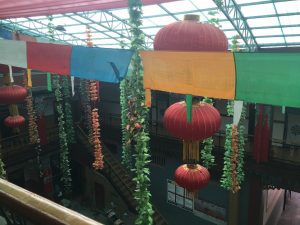
On our way there, Peter explained that to greet us, our dinner hosts would offer us a small glass of Tibetan wine, made from barley. He said that the correct way to accept the wine was to dip a finger into the wine and then flick the finger away from you, repeating this for a total of three times. These three gestures symbolized heaven, Buddha, and people. Only after you did this, you could drink it. If you didn’t do this, it would be considered impolite.
And sure enough, when we got off of the bus at the site, there was a man who cheered for our arrival and offered tray with shot-glass sized silver cups filled with what I figured was the wine. I remember asking Peter if we were supposed to drink it all in one go, to which he said yes, so I drank the entire thing in one go. I remember the Tibetan wine being very strong yet smooth, and it warmed my belly up quite pleasantly. Both Peter and the man who gave us the wine were very impressed by my ability to drink it all. It’s safe to say that we all loosened up a little after drinking that small shot of Tibetan wine.
Walking onto the site, we noticed a lot of colorful tents and fluttering prayer flags everywhere. Somewhere around the middle of the site was a tall pole with even more prayer flags. There were other tourists visiting the area, some trying on vibrant traditional Tibetan clothes to take pictures with, others just taking pictures out in the grass plain with the mountains and the setting sun in the background. Our group was lead inside probably the largest tent, where there were many round tables scattered around with a stage that had the Tibetan grassland horizon as a backdrop at the front. After seating ourselves, we were served various dishes with Tibetan noodles, meats, and veggies, and we enjoyed each other’s company, joking around and laughing away the day spent mostly traveling. Once we had finished our meal, our hosts entertained us with a traditional Tibetan Guozhuang dance and some Tibetan singing as well.

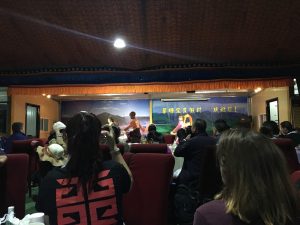
After the performance on the stage, we were invited outside into the cold night, where the bright full moon greeted us. Our hosts lit up a warm bonfire, and just when we all gathered around it to warm ourselves up, they put on some loud dance music on speakers. All of the guests were encouraged to dance around the bonfire and enjoy themselves. My friends and I jumped right in, joining the circle of people holding hands and just dancing however they saw fit. Fireworks lit up the sky as we laughed and danced together and with other tourists who were there.. The fireworks were bigger than any fireworks I’ve seen in the U.S. — in fact, they were so big and seemingly close to the ground that my friends and I got a little worried!

Eventually, our trip leaders ushered us back to the bus. We were still hyped up from our enjoyable time at the Tibetan dinner, as shown by our chattering on the way back to the hotel even though it was around 10pm. That was when Peter came up to the front of the bus and sang us a love song in Chinese. His voice was just as soft and soothing as his regular voice, and we all broke into applause when he finished. Then, he told us that since he sang a song for us, we should sing a song for him. Hilarity ensued as some of us walked all the way up to the front of the bus and took turns singing all different kinds of songs. We have some Columbian students on the program, so some of them sang some Spanish songs. Someone came up and sang a High School Musical song, and you know that we all joined in on that!
Once we got back to the hotel, in the darkness of the hotel lobby, before we retired to our rooms, a group of us, half-asleep and tired from the day, planned to go circle the 1.5 mile long Labrang Monastery wall and spin the Buddhist prayer wheels early in the morning. It was a rather smaller group, about maybe 6 or 7 of us. Little did I know that I would come out of that morning with an experience that I now hold precious to me.
Labrang Monastery and Sky-Burial Site: A Day I’ll Never Forget
I woke up around 5:30am and quietly put on layers of clothing to protect myself from the cold morning. As I got ready, I remember thinking that I didn’t know exactly what I was getting into, but I knew that I just wanted to experience it. I knew that I wouldn’t get another chance like this again, so I figured I would sacrifice some precious hours of sleep to go experience this morning hike. I met the other students downstairs in the lobby, and then we headed out into the cold early morning to the Labrang monastery, a very important Tibetan-style Buddhist temple grounds to the Tibetan people. Many people make pilgrimages to this temple to pray at it.
We walked over to the Labrang monastery, which was a short distance away from our hotel. We were unsure what we were supposed to be doing for this hike. Most of the information we were given about this optional activity was pretty minimal (in the Travel Bible, it only said “Suggestion: Early morning walk to the Labrang Monastery to join the local pilgrimage by circling the 1.5 mile long Monastery wall and turning the thousand of prayer wheel”), so we decided to rely on watching what the locals did. We followed as some locals walked up to what I figured was that 1.5-mile long wall, which was covered with endless amounts of prayer wheels, and started to spin each of them as they walked past them.
Let me explain what prayer wheels are, since I’ve thrown the word around a couple of times now without saying what they were. They are vertical wooden structures that have very colorful Buddhist motif paintings on them, and inside of them are prayers written on a scroll of paper. The belief is when these wheels are spun, the prayers inside of those wheels are “spoken” and then carried off into the wind.
We continued to walk, and walk, along the wall of the monastery, all the while spinning those wheels. Some of them were visibly worn from all of the years they’ve been spun, with their vibrant red paint fading where the people pushed them. As they spun, they made a soft creaking noise. At first, we giggled at how some of our arms were getting tired pushing the wheels so that they would continue to spin. The wheels were surprisingly heavy to push! But after awhile, we fell silent, taking in the experience. What happened next was something that I’ll never forget.
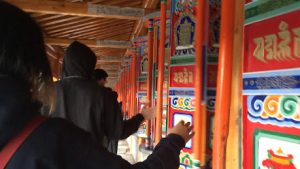
I come from a Buddhist family, and so I figured I would pray as we spun the wheels. At the time when I initially decided to pray, I didn’t think much of it. I had prayed before at temples back at home, and I figured that it would just be something nice to do My prayers were silent and internal, so no one really knew I was praying during our walk. But when I was praying, I started to feel something stir within me. It’s really, really difficult for me to find the right words to describe the sensation in a way that would make sense, and I apologize ahead of time if it doesn’t.
You know that feeling when you’re about to cry, but then you hold back your tears? That feeling that starts in your chest and spreads up to your eyes and your nose? What I felt was only similar to that feeling. I didn’t feel like I wanted to cry, nor did I feel like I was going to cry, but I became emotional, to say the least. Maybe I did feel like I was going to cry, but it feels a little weird to label it as so. My chest just tightened momentarily, and my gut felt strange. Walking against the walls of the monastery while spinning those worn, yet colorful and vibrant, prayer wheels, suddenly became something… magical. Something incredible. As the cold morning air blew while we pushed the prayer wheels to spin, I really did feel like… like my prayers were being heard carried off into the heavens by the wind. Because I had prayed for some personal things, feeling that way meant a lot to me.
After awhile of spinning the wheels, we followed the locals up into the mountains on a trail that still followed the walls of the monastery. It was quite the hike to walk along that dirt path, watching as some locals paused in certain areas to put their forehead against the monastery wall momentarily before moving on. As I paused every once in awhile to take everything in, the cold air stinging my lungs, I saw the beautiful sunrise kissing the valley with its warm light. I forgot about the strain of the hike. I forgot about how sleepy I was, how cold my nose was. I just focused on the amazing views right in front of me. We watched as the valley slowly woke up as the sun climbed higher and higher into the sky, greeting us early risers with its beauty. I remember I kept repeating to my friend who walked alongside me for most of that part of the hike, “This is amazing.”
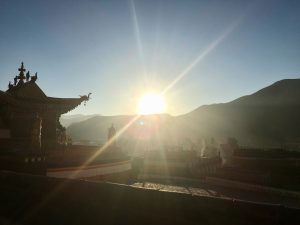
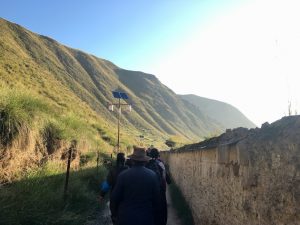
Looking back on it, as I write this blog, “amazing” doesn’t wrap up the experience neatly. It doesn’t describe the experience in its entirety. It doesn’t describe the awe I felt when watching Tibetan Buddhists dutifully walking along the trail chanting and praying underneath their breaths while I huffed and puffed to keep up. It doesn’t describe the… the “spiritual intenseness” of my emotions as I prayed for personal and intimate things in my life. Before that morning, I had never thought that I was spiritual. I never thought that, after walking alongside my fellow students and the locals on the trail around the Labrang monastery, spinning thousands upon thousands of prayer wheels, I would hold those memories, those views, those feelings, dear. But ever since that morning, I’ve grown spiritually, and our visit to Xia’he became a lot more personal than I thought it would be.
We ended our morning walk once we stumbled upon the same area we had started at about 2 hours earlier. I felt strangely energized even though I was sleep deprived and a little tired from the long walk. I came back to my hotel room and instantly messaged my family and some of my friends back home to tell them what I went through. I had to tell my roommate for the Silk Road what I had experienced. My heart felt fuller, and I felt more calmer. A sense of peacefulness and reassurance filled me. These words that you’re reading on your screens can’t just describe the feeling of that morning well enough.
At around 8:30am, we had breakfast at the hotel. Breakfast consisted of delicious bread, a yogurt that tasted very similar to Greek yogurt, only more thicker and more sour, and a sweet jam, served with tea. Servers even brought us some fried eggs. I discovered a delicious way to incorporate all parts of the breakfast: I spread the yogurt on a slice of bread first before adding a layer of jam, and then I put my fried egg on top before prompting shoving it into my mouth. I think the breakfast at the Xia’he hotel was my favorite breakfast as well.

After breakfast, we all walked to the main area of the Labrang Monastery, led by Peter. There, we had a guided tour of the monastery by a monk, who spoke very good English and was very eager to talk to us tourists. He led us into certain rooms of the temple and explained the statues inside as well as the decorations inside. We were forbidden to take photos, since it’s considered to be disrespectful, so I unfortunately cannot show you what we saw inside the monastery buildings, but the statues were impressive statues of different Buddhas, and the decorations were usually original paintings. While he gave us a tour of the monastery, the monk casually gave us some Buddhist teachings. This is where I became emotional all over again, which, again, I didn’t expect at all. I’m not so sure what it was about what he told us, but his teachings were so similar to the lessons that I’ve learned from my parents and to the morals that I hold myself to that it just resonated with me. It would be safe to say that homesickness and a yearning for home almost washed over me as I listened to this monks’ teachings. With his smiles and his agreeing grunts, I felt that he really did give us a taste of Xia’he’s Buddhism.
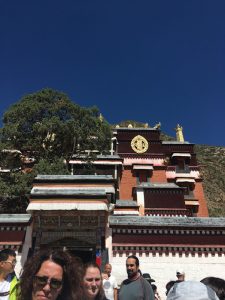
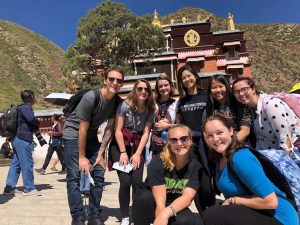
I’ll leave my favorite quote from the monk here for you to digest yourself.
“One good person can change ten bad people, but ten bad people cannot change one good person.”
Once we finished our tour of the Labrang Monastery around 12pm, we were given free time for lunch. During the free time, my friends and I wandered around looking at many different prayer beads being sold on the side of the road and in various tourist shops. After awhile of looking, I finally bought my own prayer beads to wear around my wrist to symbolize the personal and spiritual moments I had in Xia’he. I wear these prayer beads almost all the time, now.
But our day wasn’t over yet. I know, it was only 12pm and I had already done so much!
After we got lunch, we took a bus to visit the nunnery. The bus only took us to another part of town before we got off and hiked after Peter further up a path that winded through the town to get to the nunnery. There, Peter gave us a detailed tour of the inside of the nunnery’s prayer hall, explaining the different paintings on the walls and the symbolism behind them (again, we were not allowed to take any photos inside — sorry guys!). I remember being really fascinated by Peter’s teachings, comparing them with what I already knew about Buddhist motifs and symbols.
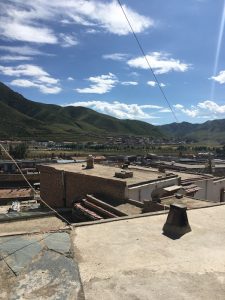
Once Peter was done giving us our tour of the nunnery, we were given an option: we could either hike back down the path to the bus and go back to the hotel, or we could make the trek up to the Sky Burial site, which was located way up further into the mountains.
Of course, you know that I chose to do the hike up to this site in the mountains.
Sky burial is an ancient Buddhist-Tibetan burial tradition. Buddhists believe that the body is only a vessel to the soul, and once the soul leaves the body, it is no longer of use. As a result, bodies of the deceased are offered to vultures, who are revered and seen as a manifestation of a flesh-eating god, as a final act of generosity to the living world and provides a link in the cycle of life. Practically speaking, the practice is ecologically friendly and is a sound way to dispose of bodies in a scarce land.
The hike to get to the site, if you went nice and slow, wasn’t all too bad. It was the thin air and the steep climbs at certain parts of the trail that got to me. Every so often, I made sure to stop and turn around to admire the increasingly incredible view behind us (and to take a ton of pictures). The city of Xia’he got smaller and smaller as we climbed higher and higher into the mountains. The blue skies speckled with white and grey clouds were just absolutely incredible to see. The weather was pleasantly cool, and the sun wasn’t shining down too harshly on us. That hike, as tiring as it was, was well worth the incredible views.
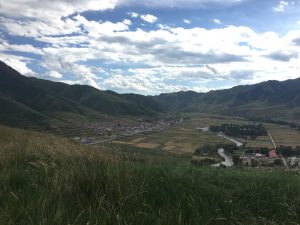
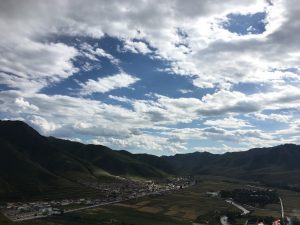
Once we got to the Sky Burial site, Peter graciously gave us some slips of paper, made to be thrown into the air as you made a wish on this little platform that looked over Xia’he. Each one of us took turns throwing our own stack of these little slips of paper into the air, cheering as we watched our wishes literally getting blown into the air by the wind.
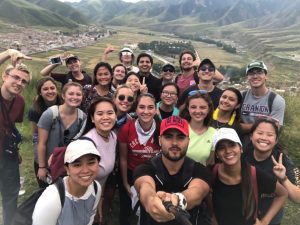
Once we were finished with our wishes at the Sky Burial site, we followed Peter even higher up into the mountains until we were over 10,000 feet above sea level (I know because I checked that elevation thing on Snapchat)! There, we took even more photos, including the cliche mid-air jumping photo. I’ll let our photos speak for themselves in terms of how gorgeous the views were.
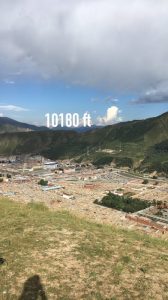
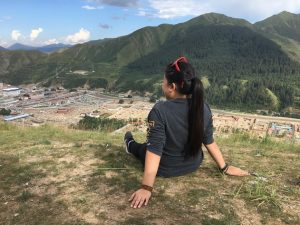
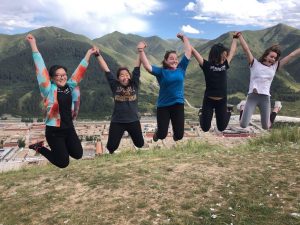
When we were satisfied with the view and with our photos, we made the trek down, making sure we didn’t lose our footing. My friends and I in particular started to sing (more like shout) Disney songs, giggling and fooling around the entire way down. We warranted some amused looks from both Peter and some of the trip leaders who were tagging along our friend group.
Once we came all the way down the mountain, we were released for dinner time on our own. My friends wandered around a little bit before we found a “fast food” restaurant, where the majority of us end up ordering this spicy fried chicken wrap. We were amused by a family sitting behind us with two rowdy children, who were equally if not more amused by our presence. At one point, the girls gave us some candy as thanks for entertaining them as their moms gossiped a little bit and got some free time to themselves.
After spending our last night at Xia’he, we took another 4 hour bus ride all the way back to Lanzhou.
Lanzhou Part 2!
We stayed in Lanzhou for two nights and one day in a really fancy gilded-in-gold hotel. During our (much longer) time in the ancient “crossroads” city, we crossed the impressive bridge over the Yellow River and hiked to the hill-top temple that gave us a look over the city of Lanzhou.
I know. More hiking. But trust me, every single time we had to do some sort of hike, it was always worth it.
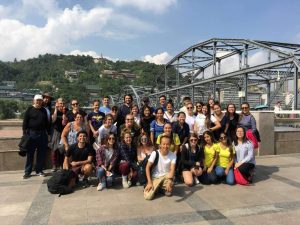
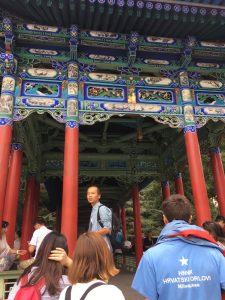
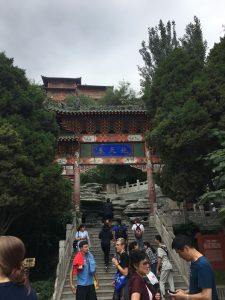
On our way up to the hill-top temple, my hiking group stumbled across another Buddhist temple, in the middle of its prayer chants.
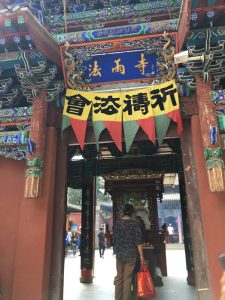
Hearing the familiar-sounding chants coming from behind the gates, I, with the reassurance of Peter, wandered in, my peers curiously following me in. The temple smelled of burning incense, and the prayers being chanted were loud and rhythmic. It reminded me of home, when I would sit in with my parents at temple during prayer chants. Naturally, a lot of my peers asked me questions about the practice of Buddhism, and I was glad to share my cultural and religious upbringing with them. Peter even bought us giant incense sticks for us all to burn. I taught everyone who wasn’t familiar with the practice of praying with incense how to do so, and by the end of it, we had contributed our own prayers and our own incense sticks to the many already burning to the chorus of chanting inside the temple.
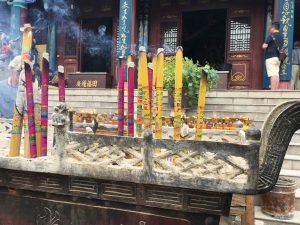
At the very top, there was another temple-like structure which acted like more like a tourist shop that sold prayer beads and jade jewelry. I spent most of my time on the balcony, enjoying the horizon of Lanzhou and bathing in the bright sunlight.
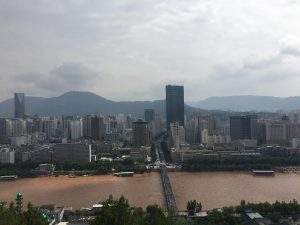
Our time in Lanzhou was really fun, but I’m quite biased. That one day in Xia’he was one of the best days for me on the trip. Not only did it allow for me to explore myself spiritually, it gave me several experiences that I continue to reflect upon now. The next day, with my prayer beads wrapped snug around my wrist and my heart feeling a little fuller than it did before we came to Xia’he, we departed on our third overnight train of the trip to the deserts to the west.
That’s about it in Xia’he and Lanzhou! I hope you all enjoyed my tales. Come back to hear all about our sandy times in Dunhuang!
Until next time~
-Justine